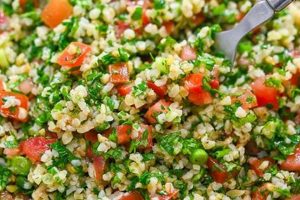Crisp and refreshing salads featuring romaine lettuce as the base offer a versatile canvas for quick and healthy meals. These dishes often incorporate simple, readily available ingredients, such as other vegetables, lean proteins, and a variety of dressings. An example might include chopped romaine tossed with cherry tomatoes, grilled chicken breast, and a light vinaigrette.
Romaine offers a satisfying crunch and a slightly bitter flavor that pairs well with numerous ingredients. As a good source of vitamins A and K, and a contributor of fiber, incorporating romaine into one’s diet can contribute to overall well-being. Historically, lettuce varieties have been cultivated for centuries, with romaine being a popular choice across various culinary traditions for its texture and flavor profile. Its resilience makes it suitable for different preparations, from chopped salads to grilled dishes.
This article will explore a variety of easy-to-prepare dishes centered around romaine lettuce, covering topics such as ingredient selection, dressing preparation, and suggested flavor combinations to create nutritious and delicious meals.
Tips for Creating Delicious Romaine Salads
The following tips offer guidance on crafting exceptional romaine-based salads, focusing on ingredient selection and preparation techniques for optimal flavor and texture.
Tip 1: Selecting Romaine: Choose romaine hearts with crisp, deep green leaves. Avoid heads with wilted or browned edges. Proper storage in a refrigerator crisper drawer extends shelf life.
Tip 2: Washing and Drying: Thoroughly wash romaine leaves under cold water to remove any dirt or debris. A salad spinner effectively dries the leaves, crucial for preventing dressing from becoming watery.
Tip 3: The Art of the Chop: Chopping romaine into bite-sized pieces ensures even distribution of dressing and other ingredients, enhancing the overall eating experience. Avoid overly large pieces that become difficult to manage.
Tip 4: Dressing Choices: While creamy dressings can complement romaine, lighter vinaigrettes often enhance its inherent crispness. Experimenting with different flavor profiles, such as lemon-herb or balsamic vinaigrette, allows for culinary creativity.
Tip 5: Ingredient Combinations: Romaine provides a neutral base for a diverse range of flavors and textures. Consider pairings with grilled chicken or fish, crunchy croutons, or a variety of fresh vegetables like cucumbers, bell peppers, and red onion.
Tip 6: Timing is Key: To maintain optimal crispness, add the dressing to the romaine just before serving. This prevents the leaves from wilting and ensures a fresh, vibrant salad.
Tip 7: Enhancing Flavor Profiles: Adding ingredients like Parmesan cheese, toasted nuts, or dried cranberries introduces complexity to a romaine salad. These additions provide contrasting textures and elevate the overall flavor profile.
By following these tips, one can elevate simple romaine salads into satisfying and flavorful meals, maximizing both nutritional value and culinary enjoyment.
The provided guidance sets the stage for exploring specific recipes and techniques in greater detail within the following sections.
1. Fresh, Crisp Romaine
Fresh, crisp romaine forms the foundation of successful simple romaine lettuce salad recipes. The quality of the romaine directly impacts the overall sensory experience. Crisp leaves offer a satisfying texture that contrasts with other ingredients, while fresh romaine contributes a subtly sweet, slightly bitter flavor that complements various dressings and toppings. A salad built on wilted or less-than-fresh romaine compromises the final dish, resulting in a less appealing and potentially unappetizing meal. For instance, a Caesar salad relies heavily on the crispness of romaine to balance the richness of the dressing and the saltiness of the Parmesan. Using subpar romaine would result in a soggy, less enjoyable salad.
The importance of fresh romaine extends beyond mere taste and texture. It also contributes to the visual appeal of the salad. Vibrant, deep green leaves create an aesthetically pleasing presentation, enhancing the dining experience. Furthermore, fresh romaine is more likely to hold its shape and texture when combined with other ingredients and dressings, preventing the salad from becoming watery or wilted quickly. This is particularly important for make-ahead salads or those served in warm environments. Consider a simple salad of romaine, cucumber, and tomato with a light vinaigrette. Fresh romaine maintains its structure, ensuring a pleasing textural contrast with the other vegetables, even after the dressing is added.
Selecting and maintaining the freshness of romaine is therefore paramount to achieving desirable results in simple romaine lettuce salad recipes. Careful attention to the quality of romaine at the point of purchase and proper storage techniques are essential. Choosing romaine hearts with firm, unblemished leaves, and storing them properly in a refrigerator’s crisper drawer, ensures optimal freshness. Understanding this connection allows for the creation of salads that are not only simple to prepare but also deliver a satisfying culinary experience.
2. Complementary Ingredients
Complementary ingredients are essential for elevating simple romaine lettuce salad recipes beyond basic greens. These additions contribute layers of flavor, texture, and visual appeal, transforming a simple salad into a more complex and satisfying culinary experience. The careful selection of complementary ingredients considers the inherent qualities of romaine lettuceits crisp texture and slightly bitter flavorto create a balanced and harmonious dish. For example, the sharpness of red onion provides a counterpoint to romaine’s subtle sweetness, while creamy avocado complements its crispness. Adding grilled chicken or chickpeas introduces protein, enhancing the salad’s nutritional value and making it a more complete meal.
The interplay of textures is another crucial aspect of incorporating complementary ingredients. Croutons introduce a satisfying crunch, contrasting with the smooth romaine leaves. Toasted nuts, such as slivered almonds or walnuts, offer a similar textural contrast while also contributing a nutty flavor dimension. Consider a salad combining romaine with roasted sweet potatoes, crumbled goat cheese, and toasted pecans. The interplay of soft sweet potato, creamy goat cheese, crunchy pecans, and crisp romaine creates a multi-dimensional sensory experience.
Understanding the role of complementary ingredients allows for the creation of diverse and personalized romaine lettuce salads. The versatility of romaine makes it an ideal base for a wide range of flavor combinations. One might pair it with Mediterranean-inspired ingredients like feta cheese, olives, and sun-dried tomatoes, or create an Asian-inspired salad with mandarin oranges, edamame, and a sesame ginger dressing. The strategic use of complementary ingredients not only enhances flavor and texture but also offers opportunities for increased nutritional value and visual appeal, ultimately transforming a simple salad into a culinary masterpiece.
3. Flavorful Dressings
Flavorful dressings play a crucial role in simple romaine lettuce salad recipes, transforming a basic bowl of greens into a culinary delight. Dressings contribute significantly to the overall taste profile, providing acidity, sweetness, saltiness, or spiciness that complements the inherent flavors of romaine and other salad components. A well-chosen dressing can elevate a simple combination of romaine, tomatoes, and cucumbers into a memorable dish. The dressing acts as a unifying element, tying the various ingredients together and creating a cohesive flavor experience. For example, a tangy vinaigrette enhances the natural sweetness of cherry tomatoes while balancing the slight bitterness of romaine. A creamy ranch dressing, on the other hand, adds richness and complements the crunch of croutons or the savory notes of grilled chicken.
The impact of a flavorful dressing extends beyond mere taste enhancement. It also contributes to the overall texture and mouthfeel of the salad. Vinaigrettes add a light and refreshing touch, while creamy dressings offer a richer, more decadent experience. The choice of dressing can also influence the visual appeal of the salad. A vibrant balsamic vinaigrette adds a glossy sheen to the romaine leaves, while a sprinkle of herbs in a creamy dressing contributes specks of color. Consider a classic Caesar salad: the creamy Caesar dressing not only provides a rich, savory flavor but also coats the romaine leaves, adding a luscious texture and enhancing the visual appeal.
Understanding the importance of flavorful dressings in simple romaine lettuce salad recipes allows for greater culinary creativity and control over the final product. Selecting or creating a dressing that complements the chosen ingredients is essential for achieving a balanced and delicious salad. Challenges may arise from balancing flavor intensity and avoiding overpowering the delicate flavor of romaine. However, experimentation with different flavor profiles, from citrus-based vinaigrettes to herb-infused creamy dressings, expands culinary possibilities. This understanding empowers one to create simple yet exceptional romaine lettuce salads tailored to individual preferences and dietary needs.
4. Simple Preparation
Simple preparation is a defining characteristic of romaine lettuce salad recipes, contributing significantly to their appeal and accessibility. The ease and speed with which these salads can be assembled makes them an attractive option for quick meals, busy schedules, and novice cooks. This focus on simplicity does not, however, equate to a compromise on flavor or nutritional value. Rather, it highlights the versatility of romaine lettuce as a base for a wide range of flavorful and healthy combinations.
- Minimal Ingredient Processing:
Romaine lettuce requires minimal processing, often just a quick rinse and chop. This reduces preparation time significantly compared to salads requiring extensive peeling, chopping, or cooking of various components. For instance, a simple romaine salad with cherry tomatoes and a vinaigrette requires significantly less preparation than a salad involving roasted vegetables or complex dressings. This ease of preparation makes romaine salads a practical choice for weeknight meals or impromptu gatherings.
- Quick Assembly:
The assembly of romaine lettuce salads is typically straightforward and quick. Once the ingredients are prepared, combining them takes mere minutes. This is particularly advantageous for time-constrained individuals. A simple romaine salad can be assembled in the time it takes to cook other meal components, such as grilling a piece of fish or heating a pre-made soup. This quick assembly makes romaine salads an efficient and convenient meal option.
- Adaptability to Various Skill Levels:
The simplicity of romaine lettuce salad recipes makes them accessible to cooks of all skill levels. From novice cooks to experienced chefs, anyone can create a delicious and satisfying romaine salad with minimal effort. The basic techniques involvedwashing, chopping, and tossingare easily mastered, empowering individuals to confidently create their own variations. This adaptability contributes to the widespread popularity of romaine salads across diverse culinary backgrounds.
- Versatility in Flavor Combinations:
While simple in preparation, romaine lettuce salads offer a wide range of flavor possibilities. The neutral flavor profile of romaine acts as a blank canvas, allowing for a diverse range of complementary ingredients and dressings. From classic combinations like Caesar salad to more adventurous pairings with fruits, nuts, and various cheeses, the possibilities are virtually endless. This versatility ensures that simple romaine lettuce salads remain interesting and adaptable to individual preferences.
The simplicity of preparation in romaine lettuce salad recipes enhances their appeal as a convenient, healthy, and flavorful meal option. This ease of assembly, combined with the versatility of romaine lettuce, allows for a wide range of creative combinations, making these salads a practical and enjoyable choice for various occasions and culinary skill levels.
5. Versatile Combinations
The versatility inherent in simple romaine lettuce salad recipes stems from the neutral flavor profile of romaine, which acts as a blank canvas for diverse ingredient pairings. This adaptability allows for the creation of salads tailored to various taste preferences, dietary needs, and seasonal ingredient availability. Romaine’s structural integrity also contributes to its versatility; it holds up well to a variety of dressings and toppings without becoming soggy, enabling diverse textural combinations. This inherent adaptability distinguishes romaine lettuce as a foundation for salads ranging from light and refreshing to hearty and substantial. For example, a light summer salad might combine romaine with grilled shrimp, fresh berries, and a light vinaigrette, while a more substantial autumn salad could incorporate roasted butternut squash, pecans, and a maple-balsamic dressing. The potential for variation within simple romaine salad recipes is extensive.
The practical significance of this versatility lies in the ability to create numerous unique salads using a single base ingredient. This reduces meal planning complexity and encourages culinary exploration. One can adapt a basic romaine salad template to incorporate readily available ingredients or cater to specific dietary restrictions, such as vegan, gluten-free, or low-carb diets. The ability to easily swap ingredients based on preference or seasonal availability minimizes food waste and maximizes the use of fresh produce. For instance, leftover grilled chicken can be incorporated into a romaine salad for a quick and protein-rich lunch, while a surplus of garden-fresh tomatoes can be utilized in a simple Caprese-inspired romaine salad. This adaptability makes romaine lettuce salads a practical and economical meal solution.
The versatility of romaine lettuce in simple salad recipes allows for a wide spectrum of culinary expression. While challenges may arise in balancing flavors and textures, the inherent adaptability of romaine provides a foundation for continuous exploration and customization. This characteristic positions romaine lettuce as a staple ingredient for creating simple, healthy, and satisfying salads tailored to individual needs and preferences, ultimately promoting culinary creativity and enjoyment within a framework of simple preparation.
Frequently Asked Questions
This section addresses common inquiries regarding simple romaine lettuce salad recipes, offering practical guidance for achieving optimal results.
Question 1: How can wilting be prevented in romaine lettuce salads?
Wilting can be minimized by washing and thoroughly drying romaine leaves before storing or using them. Adding dressing immediately before serving also helps maintain crispness. Storing prepared salads in airtight containers in the refrigerator further delays wilting.
Question 2: What are suitable alternatives to creamy dressings for romaine salads?
Lighter vinaigrettes, such as lemon-herb, balsamic, or apple cider, offer a refreshing alternative to creamy dressings, enhancing romaine’s crispness while adding a tangy flavor dimension.
Question 3: Beyond the standard additions, what less common ingredients pair well with romaine?
Ingredients like roasted beets, toasted sunflower seeds, pomegranate arils, or crumbled blue cheese offer unique flavor and texture profiles that complement romaine’s versatility.
Question 4: How can romaine lettuce salads be made more substantial as a main course?
Adding protein sources like grilled chicken, fish, beans, lentils, or hard-boiled eggs elevates romaine salads into more satisfying main courses. Incorporating whole grains like quinoa or farro further enhances nutritional value and satiety.
Question 5: What are effective methods for properly storing romaine lettuce?
Storing unwashed romaine in a perforated plastic bag within the refrigerator’s crisper drawer helps maintain optimal freshness. Washed and dried romaine can be stored in airtight containers lined with paper towels to absorb excess moisture.
Question 6: How can one avoid soggy romaine salads when packing them for lunch?
Packing dressing separately and adding it just before consuming prevents the salad from becoming soggy. Layering heartier ingredients at the bottom of the container and placing more delicate items like romaine on top further protects against moisture and maintains crispness.
Understanding these frequently asked questions equips individuals with the knowledge to create and enjoy simple romaine lettuce salads that are both flavorful and convenient.
The following section will provide specific recipe examples incorporating the principles and tips discussed throughout this article.
Simple Romaine Lettuce Salad Recipes
Simple romaine lettuce salad recipes offer a versatile and accessible pathway to incorporating fresh, nutritious ingredients into one’s diet. This exploration has highlighted the importance of fresh romaine selection, the strategic use of complementary ingredients, the impactful role of flavorful dressings, the ease of preparation, and the inherent versatility offered by this leafy green. From classic combinations to innovative creations, the potential for crafting satisfying and flavorful salads using romaine as a foundation is vast. The discussed principles provide a framework for elevating simple salads into culinary experiences that are both nourishing and enjoyable.
The adaptability of romaine lettuce empowers culinary exploration within a framework of simplicity. Continued experimentation with diverse ingredients, dressings, and flavor profiles promises a continuous evolution of romaine-based salads. This adaptability ensures that simple romaine lettuce salad recipes remain a relevant and adaptable culinary staple, contributing to both healthful eating and culinary enjoyment for years to come.






